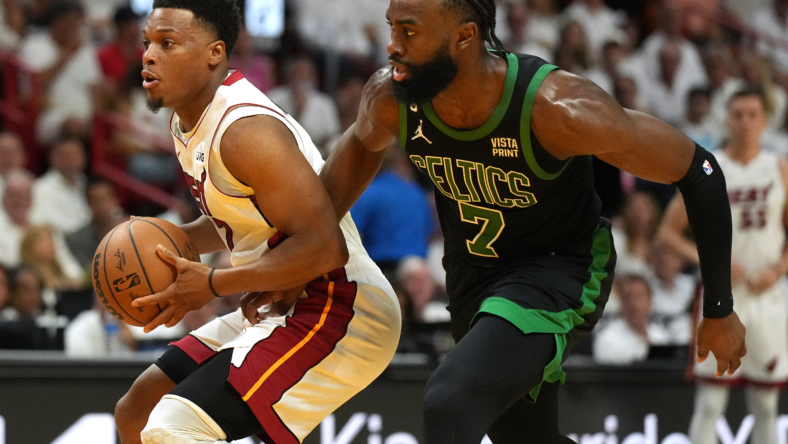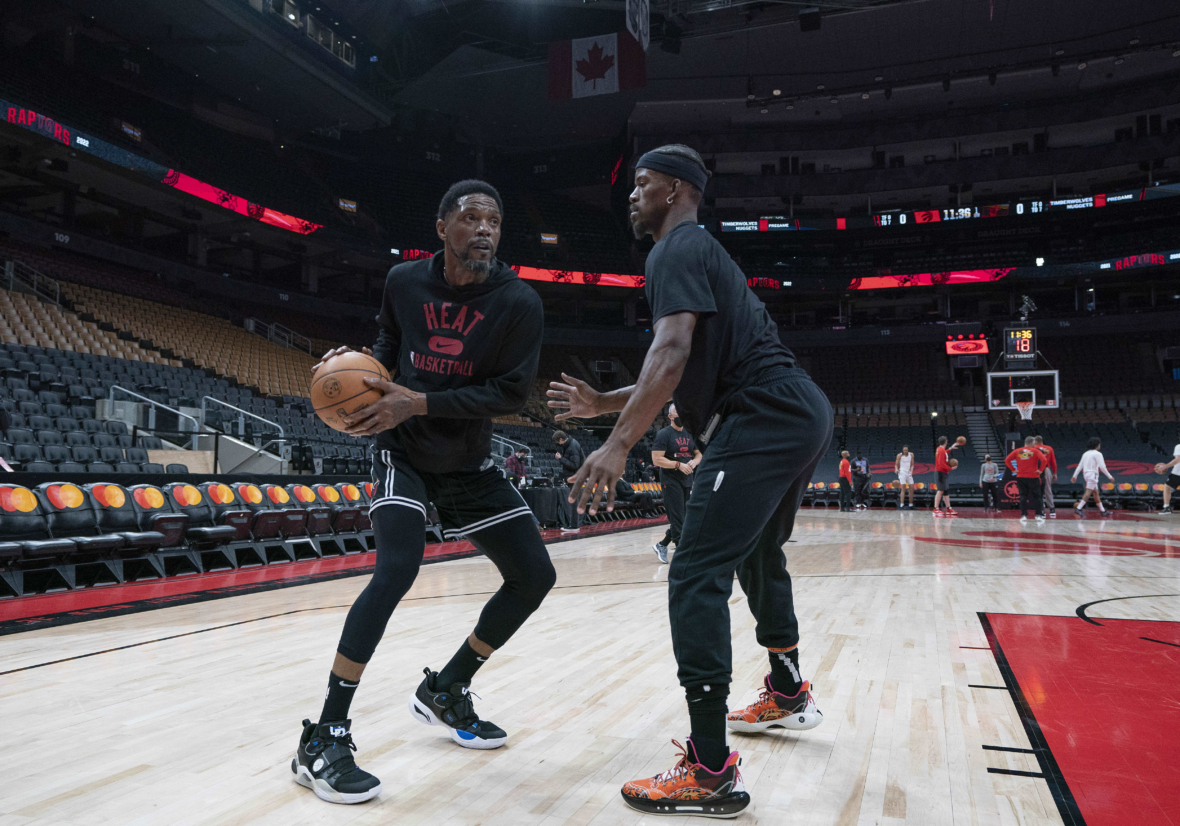
You can usually tell the degree of poverty and dysfunction an NBA team is afflicted by based on how their team is constructed, their level of turnover, and frequent trades. Look at the revolving door of coaches in Charlotte, the sequential failed trades of the Dallas Mavericks, and the failed “buy a contender” in Brooklyn.
Meanwhile, the Miami Heat have had just three head coaches since 1995 — Pat Riley, Stan Van Gundy, and current elite tactician Erik Spoelstra. In the last 28 years, Spoelstra and Riley have coached the Heat for all but three seasons, when Van Gundy was at the helm between 2005-08. That level of NBA sustainability and cohesion is unrivaled outside of San Antonio, which has employed all-time great coach Gregg Popovich since 1996.
After leaving the New York Knicks organization as head coach via fax, Riley brought with him the black and blue Knicks ethos to Miami. Over the last 30 years, the team has targeted players who fit their culture of no-nonsense, peak conditioning, and sky-high basketball IQ. They have constructed their roster over the decades primarily through the draft and free agency. This has led them to three championships since 2006 while reaching the Finals six times, with a likely seventh coming in these playoffs.
The Miami Heat lead the Boston Celtics 3-0 in the Eastern Conference Finals, with Game 4 in Miami Tuesday night. The Celtics were the No. 2 seed this season, ending the regular season with a 57-2 record. The Heat had to battle in the Play-In Tournament just to secure the No. 8 seed before turning it up several notches to beat the Milwaukee Bucks in five games, the Knicks in six, and now could sweep the battled-tested Celtics.
Their third-leading scorer, Tyler Herro, has been out since Game 1 of the postseason, yet Miami has ridden Jimmy Butler, Bam Adebayo, and a collection of undrafted gems to the top of the Eastern Conference.
So how the have the Heat accomplished the greatest Cinderella story in the last decade without their third (Herro) and fifth (Victor Oladipo) leading scorers?
How Miami Heat’s roster was built

The current Heat playoff rotation was built primarily through the draft and free agency, except for Butler, who was acquired in 2019 as part of four-team trade from the Philadelphia 76ers. Butler has been the best player in the playoffs, averaging 29.9 points, 6.7 rebounds, 5.6 assists, and 2.2
steals on shooting splits of 51.1 field goals/35.7 3-pointers/81.0 free throws.
The Miami Heat’s second-best player, defensive enforcer, and underrated playmaker, Adebayo, was taken 14th overall by the Heat in the 2017 NBA Draft. He has turned into a four-time NBA All-Defensive Second Team (2020-23) and two-time All-Star (2020, 2023). Adebayo anchors the Heat’s defense, influencing their second-overall net rating in the playoffs.
Kyle Lowry, Kevin Love, and Cody Zeller were signed as free agents. After the trade deadline, Zeller and Love were picked up from the bargain bin waiver wire. Both have anchored the center position, giving Spoelstra two very different options at the five, depending on matchups. Lowry, who’s 3-year, $85 million signing before the 2021-22 season was heavily criticized, has thrived since being moved to the bench in March after his return from a knee injury. No other playoff team could claim a championship point guard off their bench. Lowry, who had started 677 straight games when active, provides leadership and sharpshooting for the second unit while also guarding the opposing team’s backup guard, saving his energy for crunch time.
The core of the Miami Heat’s rotation features four former undrafted players who have boosted the Heat’s anemic regular season offense (25th rated) to the second-best offense in the playoffs. Point guard Gabe Vincent, and wings Caleb Martin, Duncan Robinson, and Max Strus have defied expectations and formed the most unstoppable supporting cast in the postseason.
In Game 3, Vincent, Martin, and Robinson all scored 18 points or more. With Butler limited to just 16 points, Vincent stepped up for a career-high 29 points on 6-of-9 shooting from beyond the arc. Robinson, who was also chided for his bloated contract and was benched for stretches of the regular season, chimed in with 22 points on 5-of-7 shooting from 3-point range. Martin added 18 points on 4-of-7 shooting from three. The four undrafted gems were selected by the keen eye of Riley, who has continued to find players on the margins for three decades to support his team’s identity.
The Miami Heat player development program has been working its magic since the early 2000s, rehabilitating players in the twilight of their careers: Antoine Walker, Jason Williams, Chris “Birdman” Anderson, Juwan Howard, Joel Anthony, and Goran Dragic. They’ve also found starters late in the first and second rounds (Norris Cole, Mario Chalmers). But perhaps no player best represents Heat culture or Riley’s ability to find hidden gems in the draft than Udonis Haslem.
Udonis Haslem the Heat’s heart and soul

After securing Dwyane Wade with the second pick in the 2003 NBA Draft. He then found Haslem out of Florida University. Haslem was part of all three Heat championships in 2006, 2012 and 2013. Haslem was especially key in the 2006 Finals comeback, when Miami was down 0-2 to the Dallas Mavericks.
As Haslem said himself about the worth of looking beyond the draft for NBA talent, “I think organizations are doing a better job of doing their homework and not just assuming, because a guy didn’t get drafted, that he can’t help you win,” Haslem told the The New York Times. “You can’t measure character or discipline or accountability at the draft combine, and a lot of those things sometimes get overlooked.”
Haslem is in his final year, as he announced his retirement to start the season. He was there for the Shaquille O’Neal/Wade tandem and was the heart and soul of the Heatles when LeBron James and Chris Bosh formed the greatest superteam in NBA history with Wade in the early 2010s. He’s only played in seven games this season, but he’s been a key force on the bench, mentoring the team’s young players and providing an enforcer for Spoelstra.
This has extended to keeping even Butler in check when a spat erupted between him and Spoelstra in a March 2022 game. Many counted the Heat out after that altercation. How did Spoelstra respond in the game’s presser? “Everybody was wondering where the dinner plans were after the game.” Heat culture doesn’t just promote toughness on the court. It allows space within the team to air out differences with equal fury. That level of trust and comfort has unified the Heat, creating a team without secret agendas or loose accountability.
Keeping Spoelstra and Riley in place over the last decade and more has fostered trust within the organization. Players like Herro, Robinson, Adebayo, and Butler were rewarded for their roles in the 2020 NBA Finals run with big contracts. As were former Heat guys Shane Battier, Haslem, Alonzo Mourning, and Howard before them. More than any player in team history, Butler embodies the Heat’s gritty identity.
Wade will go down as the greatest Heat player ever, James as the most talented, but Butler will be the player that most defies Heat culture. His lack of athleticism is made up for in basketball IQ and leadership, signifiers Riley has looked for in every corner of the NBA for almost 30 years. It has been nine years since James left the Miami dynasty to return home to Cleveland. Riley didn’t flinch from the gameplan in those nine years after losing arguably the greatest player of all time. He kept doing what made Miami an attractive place for James to begin with — draft, develop, demand. These Heat are answering the call.
Lee Escobedo covers the NBA for Sportsnaut. You can follow him on Twitter at @_leeescobedo